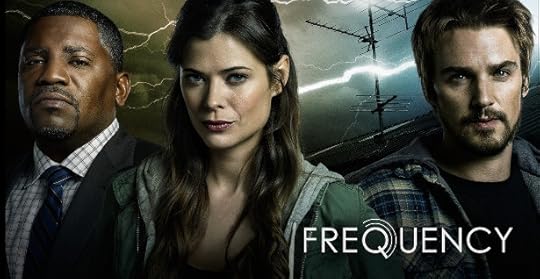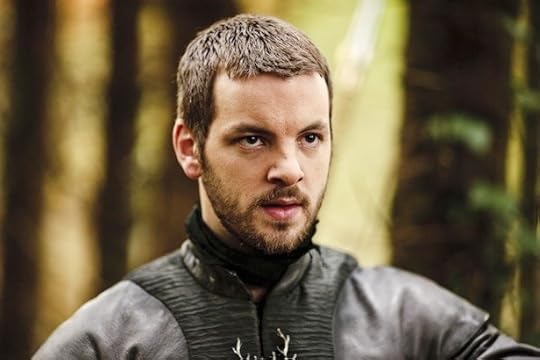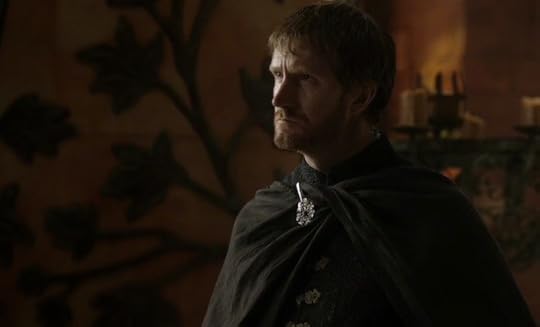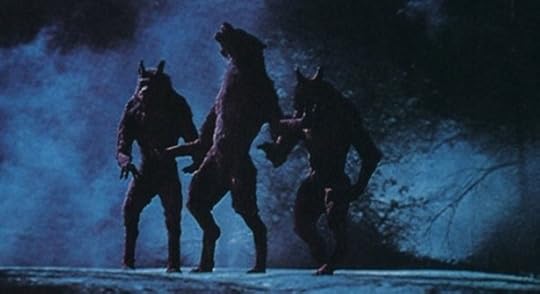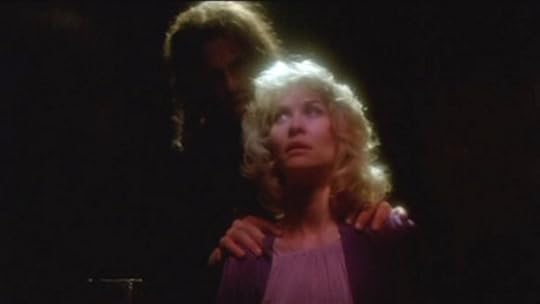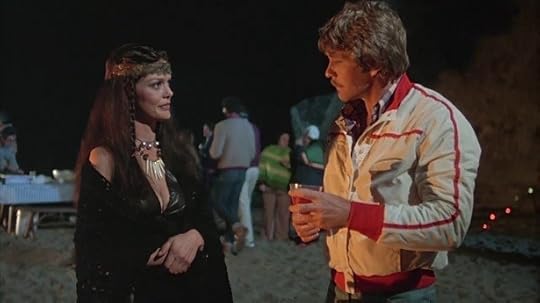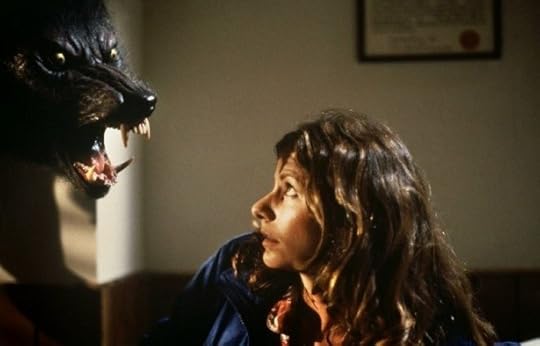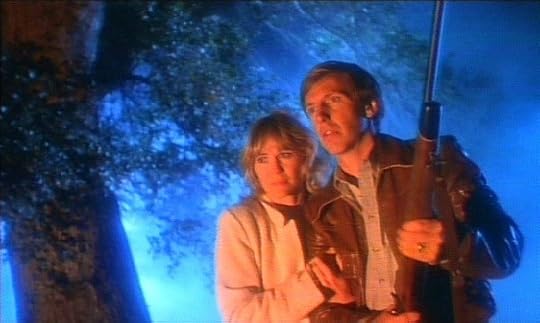Chris Hardwick's Blog, page 2352
August 11, 2016
Here’s How CW’s Gender-Swapped FREQUENCY Will Differ From the Movie
When it came out in 2000, the science-fiction film Frequency generated a lukewarm response at the box office, but the CW’s television adaptation of Frequency finds fertile storytelling ground by exchanging its tale of a son communicating with his long lost father via ham radio for one in which a young woman (played by The Flash‘s “Golden Glider,” Peyton List) connects with her deceased dad (Daniel Bonjour). The two stars were joined by their castmates Mekhi Phifer, Devin Kelley, Lenny Jacobson, Daniel Bonjour, and Anthony Ruivivar at Thursday’s Television Critics Association‘s summer press tour; along with executive producers John Rickard, Dan Lin, and Jennifer Gwartz, and creator Jeremey Carver (best known for his tour of duty on Supernatural).
“We wanted to age down our characters a bit more,” says Carver of the show’s twenty-year time span versus the film’s thirty years. Carver elaborated by adding that it aided in the choice to have actors play both younger and older versions of their characters. “It is a difficult challenge. We’re succeeding on an episodic level. That was a creative decision we made. I’m happy it’s working.”
Given that the show’s pilot covers much of the same ground as the original film, fans may be curious as to just how many of her relatives Raimy will be tasked with saving throughout the life of the show…
“You see a lot of different things introduced in the pilot beyond the central mystery,” says Carver. “The show is built to have pretty strong legs. The show is not dependent on merely saving a family member. We’ve grown beyond that… Moving past the pilot, we’re gonna be living very much in 1996 and 2016. It’s about equal time as these people are living in their own times periods. We’re also seeing the time Raimy lost. Moving forward, what you’re gonna see is very much a crime drama, a family drama. There’s a soulfulness that spreads through this show, that encompasses everything about this show.”
Regarding how far Frequency‘s butterfly effect extends, Carver remarks, “It’s not a show where every week you’re gonna end up with a different foreign power ruling the United States. If history is a rope, we’re changing maybe fibers on that rope from episode to episode.”
Addressing the show’s gender swap, Carver explains that when the network brought the property to his attention:
“The CW asked me if there’s anything I would change. It felt to me much more of a challenge and that much more exciting to reinvent this project with a strong woman at its core. The idea of exploring a father-daughter relationship, where in many stories it’s limited to a ‘Daddy’s Little Girl’ type of trope, I was interested in exploding that trope and exploring a different kind of father-daughter relationship. As a writer it made the project that much more exciting for the first season and beyond.”
“An interesting comparison,” says List of the love of baseball her character shares with her dad, “is that sports was something I shared with my father. He was the one who taught me the rules of football and was able to explain the rules to me as a young girl. It was something we could relate to each other with… There’s a lot of things in the show that can catch you by surprise, as emotional and personal. It’s sometimes hard for a father and daughter to find common ground.”
As a veteran of several science-fiction shows, List admits to being a lifelong fan of the genre:
“Just because it allows for so much more imagination, and as kid that’s where you live. Initially I had to figure it out — how do you just believe? Then I did a couple of shows where I realized that’s what it’s based in. You just do believe. I got more used to doing that — making the leap and believing one hundred percent. I like how Raimy goes through that process in the pilot, given what her father does to make her believe.”
Citing her credentials, the actress adds that, “I may or may not have had a Teenage Mutant Ninja Turtles birthday party. My mom knows better… I think it was my fifth. It still kind of competes as one of the best ones ever.”
Frequency premieres on the CW on October 5th.
Are you looking forward to Frequency? Let us know below!
In NO TOMORROW, the Apocalypse is Actually a Positive Thing
Can you derive joy from the end of the world? The CW’s newest comedy is hoping that answer is “yes.” Because while most prophets of doom tend to fall into one of two categories—lost souls on street corners or pulpit-pounding evangelists—No Tomorrow‘s apocalyptic soothsayer (played by Joshua Sasse) is a much more optimistic sort of weirdo. The former Galavant star plays free-spirited mathematics whiz Xavier, who’s calculated that the end of the world is nigh, and convincing new flame Evie (Tori Anderson). Though not wholly convinced of Xavier’s proclamation, Evie proceeds to create a bucket list (or “apocalyst”) to approach life with a fresh, new philosophy born of spontaneity and joy.
So here it is, folks: the first-ever happy-go-lucky apocalypse show!
Co-creator Corinne Brinkerhoff explained at Thursday’s Television Critics Association summer press tour that, “there’s certainly plenty of apocalyptic doom kind of shows,” she explained. “[We have] an apocalyptic joy kind of show. As [funny] as that might sound, there’s something we can fundamentally understand and relate to.” Executive producer Ben Silverman called it, “a feel-good, uplifting show about the end of the world.”
For Brinkerhoff, No Tomorrow‘s premise is less about stopping the end, and more about embracing the inevitable with a positive spin. “What if it’s true? What if his math checks out? And it may very well. What do we all need to do to better seize the day and stay in the moment? We all fundamentally know on a gut level that the clock is ticking, and there’s no guarantee of any time. What if you explored that in a way that felt joyful and spontaneous as opposed to doom and gloom? That’s what we love about making the show.”

But don’t think Xavier’s predictions will go down all that easy. “Does she think he’s certifiable?” asked producer Maggie Friedman of Evie’s point of few. “I think that’s the central questions of the show … It’s something she struggles with and grapples with, but at the end of the day he’s so intriguing and captivating that she’s drawn to him no matter what. … That’s gonna be a struggle.”
Of course there’s also the question of whether or not she can “still love him if she learns he’s crazy” and not an actual doomsday prophet, which will be a big part of the duo’s struggle.
“We’re gonna have a lot of fun teasing the audience and keeping them guessing as to his level of sanity,” explained Brinkerhoff. “But he might be the sanest one of all. Because he obviously knows the secret of life, which is that you do have to seize the moment. Because nothing is guaranteed… It’s a philosophy that she derives enjoyment from. So whether the math involved checks out with every scientist sort of becomes secondary to what they discover about this way of life.”
As No Tomorrow progresses, the producers explained, Evie will find Xavier’s philosophy affecting not only her life, but her friends’ lives as well, resulting in a series that’s as much workplace comedy as it is a romantic sci-fi one.
“A big part of the show,” explained Friedman, “is the Xavier character’s philosophy spinning out and inspiring all the characters on the show to live their best life and get over their fears.”
“If you had a finite amount of time or if you won the lottery,” says Brinkerhoff, “the first thing you do is quit your job, right? But what we found with Evie and the journey she’s on is that there is something she derives from that that gives meaning and value, and there’s something she’s reaching for that gives her meaning and value. … We’ll see the ripple effect as that spreads through the workplace and the people in her orbit, and what everybody’s reaction is to that. What is their own bucket list?”
Whether or not his calculations prove correct, Sasse says his character is most definitely not a conspiracy theorist.
“For him it’s not a conspiracy. It’s not a whodunit or is it, could it, would it be: he’s come up with a mathematical solution to this. For him, it’s definite. It’s empirical truth. To approach a character you have to fundamentally believe in the thing you do. You try to embody that. I would avoid saying he’s a conspiracy theorist.”
As for whether or not the show will ever reach the doomsday that Xavier has foreseen, Brinkerhoff explained that “the original format did have a running clock” and that “it’s something we’ve thought about” but “haven’t necessarily landed on. Because we don’t want to put to fine a point onto where we are. The idea is to stay in the moment, live in the moment. That drives the [show]. Whether we’re at six months or seven months or eight months. But it is something we’re looking and thinking about in terms of our long-term plan… It’s just a question of when we want to reach that day within our show.”
Until doomsday arrives, Anderson will continue developing new skills as her characters works on her bucket list. The actress says she’s already learned everything from singing to hopscotch to ballroom dancing to breakdancing. “In today’s world,” added Sasse, “this is a really important lesson to grasp, of putting your phone down and doing something with your day.”
No Tomorrow premieres on October 4th. Are you looking forward to No Tomorrow? Let us know below!
Images: The CW
Audio Rewind: Remembering John Cage, The 20th Century’s Most Important Musician
Who was the most important musical figure of the 20th century? It’s a loaded question with contention written all over it, but it’s one worth asking. There are a number of viable answers. Woody Guthrie. John Coltrane. Ella Fitzgerald. Phil Spector. Chuck Berry. Bob Dylan. George Clinton. Nina Simone. Elvis. David Bowie. Prince. Brian Wilson. Some aggregate of the Beatles. All were formative and integral to the state of music’s development. These names are largely responsible for today’s music scene, a fluctuating stasis of genre borrowing and niche fragmentation (e.g. chill wave/dark wave/no wave/new wave/post wave). But it took an experimental mindset to make music evolve in the way that it has. Someone needed to grant these musicians permission to reach across the aisle, think upside down, and generally do whatever the hell they wanted–no context or pretense necessary. And the man who did this most prominently was John Cage, the most important musical figure of the 20th century.
Before he was playing amplified cacti and other plants with a feather, John Cage was simply a pathfinding student in California. Cage was born in Los Angeles in 1912 and grew up playing the piano. By the time he graduated as valedictorian of his high school, though, he had given an award-winning speech on silence at the Hollywood Bowl (an important theme in his career–more on that later) and decided he wanted to be a writer.
Cage matriculated at Pomona College in 1928, where he was exposed to pioneering artists like Marcel Duchamp, James Joyce, and art music experimentalist, Henry Cowell. He then dropped out of school in 1930 after experiencing what he felt was the ineptitude of institutionalized education. His reaction largely sums up his artistic MO: “I was shocked at college to see one hundred of my classmates in the library all reading copies of the same book,” he said in his autobiography. “Instead of doing as they did, I went into the stacks and read the first book written by an author whose name began with Z. I received the highest grade in the class. That convinced me that the institution was not being run correctly. I left.”
Cage subsequently traveled to Europe, where he began experimenting with writing music based on dense mathematical systems, and he would ultimately choose music as his life path. Cage’s interest in serialism, a method of composition that uses values to manipulate music, led to a brief communique with Cowell, who suggested Cage study with prolific serialist, Arnold Schoenberg. Cage would do so for two years. Schoenberg, whose twelve-tone system of composing remains the most notable of all serialist languages, wasn’t impressed by Cage’s compositional skills, but he did declare him an “inventor… of genius,” according to Cage’s A Year From Monday, and Cage would soon adopt the inventor moniker as his stylistic tag.
His invention of the prepared piano, an instrument in which objects are affixed to piano strings in order to change their timbre, bolstered his reputation as both inventor and trailblazer. He employed the device in a percussion ensemble, which brought Cage his first renown and led to more eminent art circles with people like Max Ernst, Peggy Guggenheim, Duchamp, Morton Feldman, and Jackson Pollack. As he ascended, he became disillusioned by traditional music as a form of communication and began studying zen buddhism and eastern philosophy. He wrote in his 1973 book, M, that one of his students, an Indian woman named Gita Sarabhai, shared with him the idea that music is meant “to sober and quiet the mind, thus rendering it susceptible to divine influences.”
This philosophy would help solidify Cage’s idea that music might be better served if free of the composer’s will. In a 1991 interview with Miroslav Sebestik, he reflected on that sentiment:
“When I hear what we call music, it seems to me that someone is talking. And talking about his feelings, or about his ideas of relationships. But when I hear traffic, the sound of traffic—here on Sixth Avenue, for instance—I don’t have the feeling that anyone is talking. I have the feeling that sound is acting. And I love the activity of sound […] I don’t need sound to talk to me.”
In 1951, he began consulting the ancient Chinese divination text, I Ching, to guide his creations, and in 1952 he would compose his most famous and controversial piece of “music”: 4’33”. The three-movement composition, which calls for any instrument or combination of instruments, instructs the player(s) to spend four minutes and 33 seconds not playing. More than any other composition in the 20th century, it demanded that we asked the question: what is music? Do we need a rhythm and ordered set of pitches to call something music, or can it be anything at all?
4’33” prompted the oft-quoted Cage line: “Everything we do is music.” And it inspired musicians to begin thinking of music and sound in more abstract ways. His influence has been acknowledged by Sonic Youth, Brian Eno, Frank Zappa, and Radiohead, and he is often regarded as the forefather of New York’s renowned Downtown scene. Out of that scene came people like La Monte Young, Laurie Anderson, the Velvet Underground, Philip Glass, Steve Reich, John Zorn, Terry Riley, and Glenn Branca. Try and find a musician today that isn’t inspired by one of those people, or at least by one of the people that they influenced.
I interviewed Branca earlier this year and he lauded Cage in a very objective, matter-of-fact way: “There’s no question that the whole Manhattan downtown scene came out of Cage. He was so far in advance of everyone. I don’t think most people are aware of the fact that in the 1930s he did a performance in Town Hall where the entire group was playing nothing but animal bones. He was the first.”
Think about that. Before Elvis shocked a conservative America and shook his hips, and before Chuck Berry introduced the world to a blues-based music called rock ‘n’ roll, John Cage was playing music on bones. So, if you find yourself asking: “Where would we be without Radiohead?” or “Where would we be without Sonic Youth?” or the Velvet Underground or Eno or Zappa? Ask yourself first: where would we be without John Cage. Perhaps there would have been another that filled his shoes, or perhaps we’d be experiencing a much different, astonishingly less interesting musical landscape. He died this week back in 1992, so take a moment of silence to think about his influence. In fact, take four minutes and 33 seconds.
Image: Fotocollectie Anefo via Wikimedia Commons
STAR WARS Han Solo Prequel is Casting a Young Lando Calrissian
We have to admit, much like when we learned that Lucasfilm’s upcoming Han Solo prequel would feature his pal and co-pilot Chewbacca, we’re not surprised by this news. According to The Wrap, the Han Solo-centric Star Wars Story (a rumored trilogy that tells the story of the young, scruffy looking nerf herder’s origins) is currently casting for Lando Calrissian. We assumed that the original owner of the Millennium Falcon would make an appearance in the film, even just to show how Han swindled him out of the beloved ship.
Disney had no comment when Nerdist reached out for confirmation.
On the other side, Birth.Movies.Death is reporting an even more interesting detail: According to Devin Faraci, Community alum and star of the upcoming Atlanta series Donald Glover is the frontrunner to play young Lando. Faraci notes that there’s no official offer out yet, but it sounds like he’s the guy they want.
Much like Harrison Ford’s portrayal of Han Solo (swoon), Billy Dee Williams’ work as the smooth talking, debonaire double crosser is iconic. They already found a talented up and comer, Alden Ehrenreich, to portray Solo, and Glover would be an excellent pick to bring his own spin to the Cloud City charmer.
We first meet Lando Calrissian in The Empire Strikes Back and Return of the Jedi, but he’s made his way into other Star Wars canon recently as well. He’s appeared in several episodes of Disney’s animated series, Star Wars Rebels, and has his own comic arc, too. Honestly, we can’t imagine a young Han Solo movie WITHOUT Lando, so we’re excited to see how this all develops. (Maybe a Lando/Han heist movie like in the comics?? We’ll see.)
But what do you think of the news? Who would you like to see play Lando Calrissian? Let us know in the comments below, and don’t miss our breakdown on the rumored new Star Wars TV show from Nerdist News.
Image: Lucasfilm
Die Antwoord Thinks SUICIDE SQUAD Ripped Off Their Style
South African rap duo Die Antwoord already have experience with ong big-budget film–Yo-Landi Vi$$er and Ninja both appeared in the 2015 film Chappie— but If you ask them, though, they’d probably say it feels like they’ve been featured in two Hollywood films. Vi$$er recently posted a video on Instagram that accuses Suicide Squad director David Ayer of “jockin our style.”
The clip defines “jockin” as “to copy the likeness of and/or follow intently” and shows some side-by-side photo comparisons the definitely highlight some aesthetic similarities among Jared Leto’s Joker, Margot Robbie’s Harley Quinn, and the rappers. In the description, Vi$$er writes that Ayer called the duo and tried to establish some good will, but she wasn’t buying it: “Cara & Jared told us how much u were talkin abt us on set but u never asked our permision to rip us off. An when ninja texted u sayin wassup wif dat u said nothin like a scared lil bitch.”
A video posted by ¥O-LANDI VI$$ER (@prawn_star) on Aug 9, 2016 at 11:58pm PDT
Die Antwoord also doesn’t seem to think much of the movie, as Ninja was invited to the premiere and didn’t enjoy himself: “u invited us to ur movie premiere(which i didnt wanna go to) but ninja went , tinkin ur solid guy an mayb there was jus a lil ‘misunderstandin’. Den poor ninja had to sit thru dat hole bullshit movie.”
Vi$$er’s letter ended with a seemingly hostile invitation to meet up in person and discuss the situation: “Cum show ur pretty face at my studios. U know Muggs & u know where da Soul Assasin Studios at. we watin for u.”
While we certainly see some of the similarities the South African group pointed out, it is hard to say with any certainty if Ayers actually cribbed their style. We also wonder if this minor tiff would even be happening if not for the film’s lackluster critical reception.
What do you guys think about all of this? Let us know in the comments and on Twitter.
Are we going to get a Harley Quinn spinoff?
Featured Image: Press Here Publicity
New SUN AND MOON Trailer Reveals Alola Forms for Old POKÉMON
The team behind Pokémon Sun & Moon just can’t seem to keep a secret. We’re still a few months away from November’s highly anticipated release on Nintendo’s 3DS, but more Pokémon Sun & Moon details are continuing to get out! Last week, we got a good look at the new villains, Team Skull as well as the Alola forms for several classic Pokémon. The newest trailer for Sun & Moon reveals even more than before, and we’re breaking it down in today’s Nerdist News!
Join Nerdist News host and Ace Trainer Jessica Chobot as she offers her take on Team Skull, and the new big bads: Guzma and Plumeria. We’re also looking at the newest pocket monsters: Wishiwashi (that is one unhappy fish), Morelull, and the very disturbing Pyukumuku, who fights its battles with its guts and looks like it escaped from the movie Existenz.
But what’s really got us excited are those Alola forms! Marowak, Meowth, and Raichu all show off their new Alola forms and backstories in the new trailer, but there could be even more to come from the original lineup of 151 Pokémon. What new forms and powers will be uncovered next?
Jessica also raises some questions about the previously leaked new monsters from Pokémon Sun & Moon who are suspiciously absent from the newest trailer. We may have to wait a while to see them.
What do you think about the new Alola forms in Pokémon Sun & Moon? Are you already lining up to join Team Skull? Let’s discuss in the comment section below!
Green Day Announce New Album, Release New Single, “Bang Bang”
Green Day is one those bands that only really needs to reemerge every four years, just in time for American politics at their most visible. It is great whenever they release music, of course, but they also feel like one of mainstream rock music’s most pertinent and reliable voices of reason during hectic times. And in an election year in which a ton beloved artists have steadily remerged from the woodwork—Regina Spektor, Panic! At The Disco, Massive Attack—Green Day have thankfully returned to the fold, announcing a new album, Revolution Radio, and a a brand new single, “Bang Bang.”
We haven’t heard from the recent Rock and Roll Hall of Fame inductees since their 2012 triology ¡Uno!, ¡Dos! and ¡Tré!, so I imagine the ever-prolific songwriters have been caching music for this record steadily throughout the past four years. Based on the information at-hand, it seems like Green Day is about to release an extremely political album in the same vein as American Idiot. With lyrics like, “Oh this is love, or this is World War Zero,” and distorted guitar riffs that sound like tectonic rumbling, Green Day sound tightly wound and ready to snap about the current state of America’s political ecosystem.
In a statement about Green Day’s new record, Billy Joe Armstrong acknowledged that though the “world has lost its collective mind,” he still wants all of his fans and music lovers to “come together, dance together, [and] sing together.” Sure the veteran power punk band are going to have a lot to say, but it’s going to be a barn-burner of a time hearing them out when Revolution Radio drops on October 7 via Reprise. Check out the full tracklist below.
Revolution Radio Tracklist:
01 Somewhere Now
02 Bang Bang
o3 Revolution Radio
04 Say Goodbye
05 Outlaws
06 Bouncing Off the Wall
07 Still Breathing
08 Youngblood
09 Too Dumb to Die
10 Troubled Times
11 Forever Now
12 Ordinary World
Are you excited about the return of Green Day? Are you also about to blast Dookie for the rest of the day? Same with us.
Image: Frank Maddocks via Warner Bros. Publicity
Matt Grosinger is the music editor of Nerdist and knows that his dad will be absolutely stoked about this news.
IRON GIANT Meets GRAVE OF THE FIREFLIES in new Kickstarter Campaign
Writer/director Mike Pappa describes A Crimson Man as “a Philip K. Dick-inspired adventure seen through the gaze of a young boy.” While invoking The Kindred One is a smart move, Pappa might want to add The Iron Giant and Grave of the Fireflies to his list of comparisons, since both titles instantly spring to mind while sifting through his stunning concept art and harrowing plot line. Big robot with something to learn, young boy with something to learn, war-torn country with something to learn. It’s all there with one slight twist.
Despite those seeming similarities in story and style, and despite Pappa’s design and animation-laden résumé, he’s planning A Crimson Man as a live-action short film, and he’s asking for your crowdfunding help to make it a reality. And judging by his quirky short film Frankie, he can handle live-action as well as he manages cel-based stories.
Like most professional campaigns, Pappa and company have a thorough plan for raising and utilizing the $60,000 in funds, as well as a host of smart incentives like artwork and production credits. Here’s Pappa to sell you on his vision:
The big question will be how well Pappa can manage the practical effects that he’s attempting to build with a relatively low budget. On that front, he’s drawing inspiration from E.T., The Empire Strikes Back, and The Thing. He’s also already assembled a core team to tackle those challenges, including an animatronics lead who’s worked with Disney and Jim Henson Company and a VFX consultant with credits on The BFG and X-Men: Days of Future Past.
If every crowdfunding project is a leap of faith for the backer, Pappa and his team have done as much as they can to build confidence. Most of all by crafting an emotionally intriguing sci-fi story about nuts and bolts and the bonds of friendship.
Featured Image: Mike Pappa/Kickstarter
GAME OF THRONES with Context: “A Golden Crown” Recap (S1, E6)
Winter is coming, but not soon enough. So to help pass the time until season seven of Game of Thrones, we’re doing a weekly re-watch of the series, episode-by-episode, with the knowledge of what was to come, and more information about the yet unrevealed rich history of events that took place long before the story began. Be warned, though, as this series is full of spoilers for every season, even beyond the episode itself. So if you haven’t watched all of the show yet immediately get on that and then come back and join us for Game of Thrones Re-Throned.
Because the next best thing to watching new episodes is re-watching old ones.
——
Season 1, Episode 6: “A Golden Crown”
Original Air Date: May 22, 2011
Director: Daniel Minihan
Written by: David Benioff, D.B. Weiss, Jane Espenson
Even in the harsh world of George R.R. Martin, sometimes the good guys win and the bad guys lose—we just don’t always realize who is who at the time, like in the sixth episode, “A Golden Crown,” where Bronn and his lack of fighting “honor” saved the seemingly evil Tyrion Lannister from “flying” through the Moon Door of the Eyrie. Sometimes though we know exactly who and what we were watching, and we get to revel in it, like in this episode’s final scene.
Before that though, we start with Ned waking up from Jaime’s attack and slaughter of his men to find another Lannister standing over him—Cersei (and Robert, who was last seen threatening to have Ned’s head put on a spike). Cersei is all fire and brimstone, wanting retribution for the arrest of her brother Tyrion (funny), and Ned wants Jaime to answer for his attack, but Robert basically tells them to shut up because he loves Ned (and doesn’t want the North in open rebellion because the North is large and a pain in the ass to deal with) and he’s in debt to Tywin.

Cersei mocks Robert for not taking action, so he hits her. She says she will wear it as a badge of honor, and this is either the final moment where she elects to kill him (not even because he struck her, but because he doesn’t take action against the Starks) or it merely solidifies her resolve to do it.
The good news is Robert isn’t angry, he loves Ned too much (“I never loved my brothers. A sad thing for a man to admit, but it’s true. You were the brother I chose.”), but the bad news is he won’t let him go back to Winterfell, insisting he become Hand of the King again, especially since he needs Ned to rule while he goes on a hunt. A hunt that will be fatal for both of them.
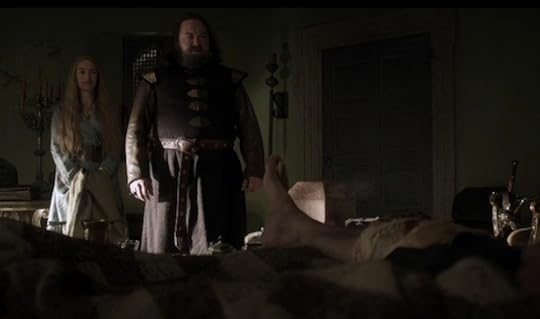
We then get another scene so full of foreshadowing I think if you turn the volume up enough you can hear the ghost of Aegon the Conqueror whisper, “These dragon eggs are definitely going to hatch,” as Daenerys lovingly looks at one of the petrified eggs, places it in a fire, picks it up, and doesn’t get burned by it, unlike her servant.
Nobody was surprised at the end of the season when she walked out of the fire with three dragons, right? It’s an amazing scene, but they weren’t exactly subtle about it happening.

From there we get a longer look at Bran’s dream of the Three-Eyed Raven, this time as the Raven flies deep into the crypts at Winterfell, an actual example of subtle foreshadowing. He’s woken up by Hodor arriving with his special, Tyrion-designed horse saddle, which gives us this glorious image.
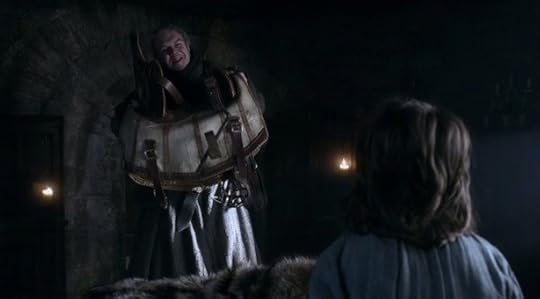
Bran then happily takes to his horse, riding with Theon and Robb. Theon wants to go to war with the Lannisters immediately (“Blood for blood”), but Robb says that’s a lot easier said than done. When Theon persists, arguing it is his duty to protect his House, Robb says, “And it’s not your duty, because it’s not your House.” I was angered by Theon’s betrayal of Robb, but looking back it shouldn’t have been that shocking. They really laid the groundwork for it.
The two then notice Bran isn’t nearby, and we find him before they do—being attacked by three wildlings, including Osha. The attackers mention Mance, White Walkers, Benjen Stark, and getting as far south as possible, but Robb arrives and brutally slices one’s throat before grabbing Osha. The leader then grabs Bran and demands Robb drop his sword. It’s all pretty tense until an unseen Theon puts an arrow in the wildling’s back, an act that gets him scolded by Robb for putting Bran at risk. Robb’s not wrong, but he’s also kind of an asshole. Theon believed the situation required action and he took it, and in the process saved Bran, even if there was a danger. They then decide to let a groveling Osha live.
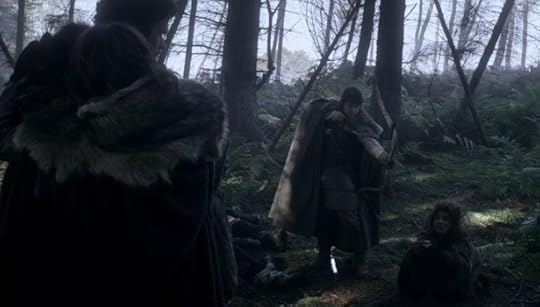
In the Eyrie, Tyrion’s life almost comes to an unfortunate end, as he awakens on the edge of his sky cell. He then calls the turnkey/prison guard Mord, asking him if he wants to be rich, but since he doesn’t have his gold on him (taken at the time of his arrest) or even really a plan (escape would be impossible), Mord just whacks him and leaves. Later, when he calls Mord again, he will show just how powerful House Lannisters’ wealth really is (as well as Tyrion’s skill in knowing how to talk to all people), when the simple-minded Mord knows what it means to be “rich as a Lannister” and that “a Lannister always pays his debts.” Mord eagerly agrees to bring the message to Lysa that Tyrion wishes to “confess” in exchange for the promise of gold. The renown (though not love) the Lannisters have in Westeros allows Tyrion to get away from his sloping room of death.

We then see a “troubled” Arya tell Syrio she doesn’t wish to practice today, but he tells her that is the exact time to do so. “Good! Trouble is the perfect time for training. When you are dancing in the meadow with your dolls and kittens, this is not when fighting happens,” he says, “You’re not here. You’re with your trouble. If you’re with your trouble when fighting happens–more trouble for you.”
Syrio was the best.
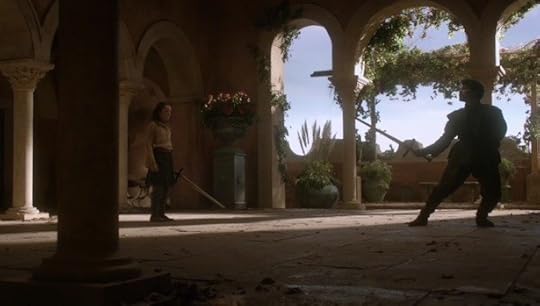
The former First Sword of Braavos then says something very similar to what a future mentor will teach Arya in that same city one day, “There is only one god. And his name is death.” However, unlike Jaqen, Syrio does not worship at the altar of death, telling her, “And there is only one thing we say to death — ‘Not today.'”
From there we head back across the Narrow Sea for a totally normal scene of a pregnant lady eating a raw horse heart.

I think we’ll let Viserys sum this one up for us:
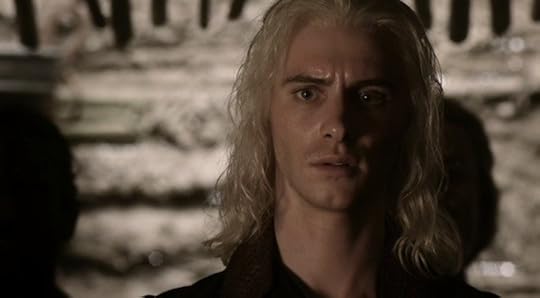
Jorah translates the chanting from the Dothraki for Viserys: “The prince is riding. I have heard the thunder of the hooves. Swift as the wind he rides. His enemies will cower before him, and their wives will weep tears of blood.” He then says she will have a boy, and he will be “the stallion who mounts the world.” Viserys, troubled by the prophecy because he can already see the threat this child will pose to his rule of Westeros, says that the boy won’t be a real Targaryen.
This prophecy from the priestess of the Dosh Khaleen—to which Daenerys will return in season six—feels very different now. Read it not as being about her son (who she said will be named Rhaego, in honor of her dead brother Rhaegar), but about her or even Drogon. That’s not good news for Queen Cersei, is it?
Viserys storms off in anger after he recognizes how much the Dothraki love his sister, and he heads to her tent to take the dragon eggs before he flees. However, Jorah confronts him and demands he leaves the eggs behind. Viserys then gives a sad little speech about never getting anything close to the love he just watched his sister get, as well about how obvious Jorah’s love for her is.
“I’m the last hope of a dynasty, Mormont. The greatest dynasty this world has ever seen, on my shoulders since I was five years old and no one has ever given me what they gave to her in that tent. Never. Not a piece of it… How can I carry what I need to carry without it? Hmm? Who can rule without wealth, or fear, or love? Oh, you stand there, all nobility and honor. You don’t think I see you looking at my little sister, hmm? Don’t think I know what you want? I don’t care. You can have her. She can be queen of the savages and dine on the finest bloody horseparts, and you can dine on whichever parts of her you like. But let me go.”
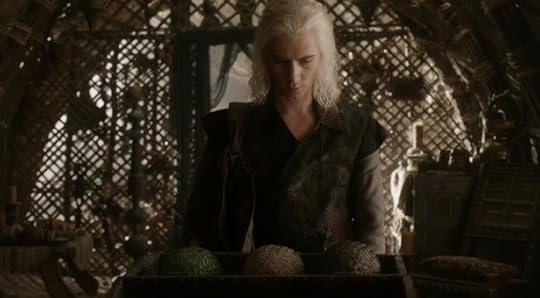
Jorah, who we know is currently betraying Daenerys to Robert and the Small Council, refuses to let him leave with the eggs, and a great moment takes place that may have been lost on non-book readers. Viserys asks about loyalty (in regards to the oath he swore to him), and Jorah says loyalty means everything to him.
“And yet here you stand?”
“And here I stand.”
The words of House Mormont? “Here We Stand.” Go re-watch this scene and enjoy those goosebumps.
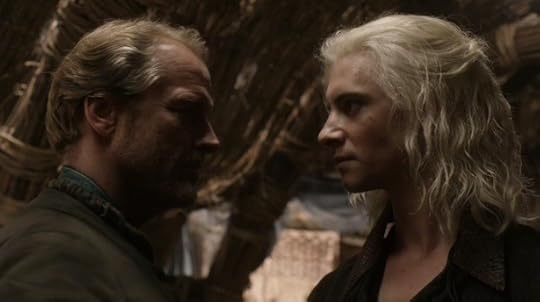
Naturally, Viserys leaves without the eggs.
Having managed to convince Mord to help him, Tyrion stands in front of Lysa, her little brat of a son Robin Arryn, Catelyn, and the court of the Eyrie to confess his “crimes.” He will do the exact same thing years later in the Iron Throne room while on trial for Joffrey’s death, though that scene and his confession isn’t funny like this sequence, where Tyrion lists a bunch of terrible things he did as a child. (The one about his sister’s soup being particularly crude and funny.)
Note: His last confession is about how he “once brought a jackass and a honeycomb into a brothel,” but Lysa cuts him off. He would begin this story/joke again in season six with Grey Worm and Missandei, but get cut off yet again before getting to the punchline. Now that we know Jon’s real mother, this is the greatest mystery on the show.
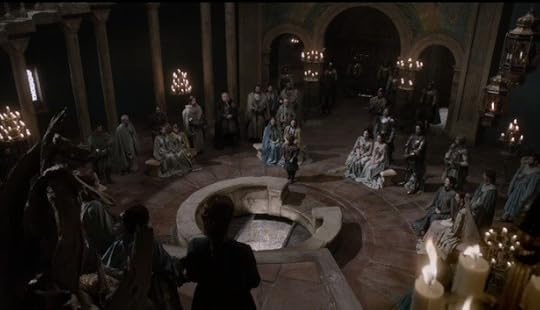
An angry Lysa says she will put him in a smaller, slope-ier (not a word) sky cell, and he demands a trial by combat, naming Jaime as his champion. Lysa says the trial will happen today and she basically forces Ser Vardis to be hers. Tyrion asks if anyone will be his, and Bronn, who laughed his way through Tyrion’s confession, and who also recognizes an opportunity when he sees one, stands up.
Ser Vardis fights like a true knight, but Bronn fights like a guy trying to actually win, and he does, slaying Vardis and pushing him through the Moon Door. This is a recurring theme throughout the show, about how a strict adherence to honor can be deadly, and sometimes you need to take the pragmatic approach. Bronn understands this as well as anyone, which is why he is still alive all these years later (and why him and Jaime’s covert operation to Dorne felt so stupid).
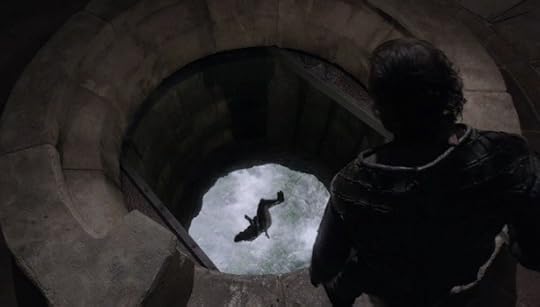
We then join the hunt, where the normally sheepish Lancel continuously comes forward and asks Robert if he wants more wine. Remember, he is drugging Robert here, which is what will lead to Robert being gored by the boar. (Kind of a stupid assassination plot by Cersei, no? But hey, it worked, so kudos.)
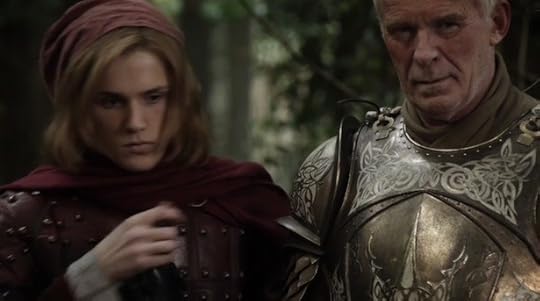
Robert embarrasses Renly, who gives a little speech about the stupidity of war and Robert’s pining for the good old days of bloodshed.
“What days were those? The ones where half of Westeros fought the other half and millions died? Or before that, when the Mad King slaughtered women and babies because the voices in his head told him they deserved it? Or way before that when dragons burned whole cities to the ground?”
Considering that Stannis is a man of war too (but without any of the mercy of his older brother) this partly explains why Renly (so stupidly) made a claim for the Iron Throne himself, and it shows the audience that Renly is a better, more caring man than his brother the king.
Renly was a good person, but his illegitimate, baseless claim cost the lives of countless people and helped to destroy his house. (Yes, in fact I do feel strongly about this.)
With Robert hunting Ned, now using a cane, is sitting on the Iron Throne when he learns that The Mountain, bannerman of Tywin Lannister, has been terrorizing the Riverlands, home of Catelyn’s family House Tully. Considering The Mountain left behind a bunch of dead fish the reason is not exactly subtle–this is about Tyrion. A coy and cunning Baelish, hoping to create more chaos, urges Ned to act (while Pycelle, secretly a loyal servant of House Lannister urges caution), and Ned turns the dial to 11. He strips The Mountain of his titles and land and demands Tywin come to court or be labeled a traitor. Ned does this in Robert’s name, which will blow up on him when Robert soon dies.
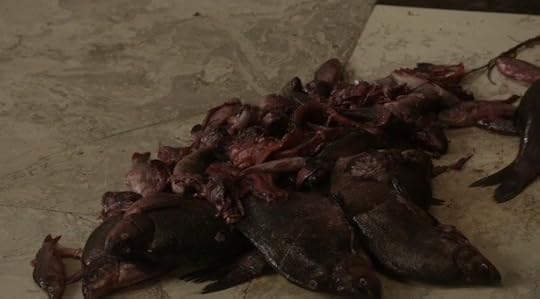
Ned sends this guy to bring The Mountain to justice:
That was the original Lord Beric Dondarrion, who will be recast when we meet up with him as a member of the Brotherhood Without Banners (either that or all those deaths really changed him).
We then see Sansa be the worst person in the world, as she is absolutely rotten to Septa Mordane, which is funny because then the actual worst person in the world, Joffrey, comes with a gift for her, apologizing for his behavior. (It’s a necklace.) He’s completely charming here, and Sansa falls for it. This sequence ends up being very important very soon, because Ned tells his daughters later that he is going to send them back to Winterfell and Sansa loses it, saying she is going to be the queen and that she loves Joffrey. This will lead to her telling Cersei about her father’s plans, in an effort to remain in King’s Landing, which tips off the Queen and ultimately helps get Ned killed.
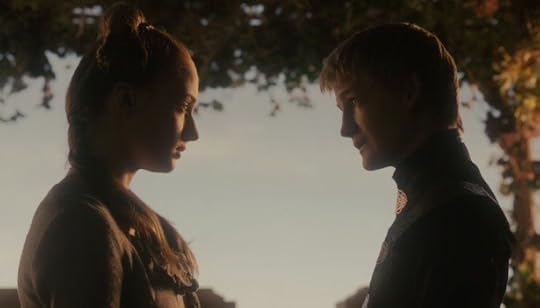
However, something Sansa says here puts all of the pieces of the puzzle together for Ned and his quest to learn what Jon Arryn was doing before his death. Sansa says she will give the golden lion Joffrey “sons with beautiful blond hair,” and Arya points out he is a stag of House Baratheon, not a lion of House Lannister. Sansa says, “He is not. He’s nothing like that old drunk king.”
When the girls leave Ned immediately goes to that giant book of noble houses and turns to House Baratheon, where he sees that all men of Baratheon blood have dark hair, whereas Joffrey has golden hair like the Lannisters (the first of two “golden crowns” referenced in the episode’s title).
“The seed is strong” were Jon Arryn’s last words, and all of Robert’s bastards have his dark hair. Ned realizes Robert’s children are not truly his.
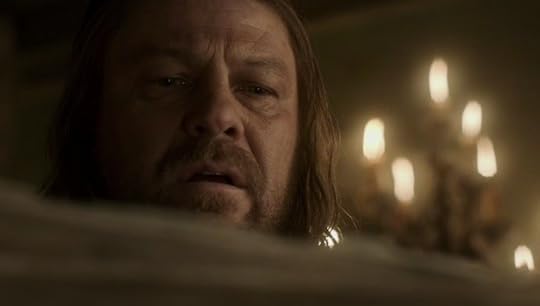
History note: Ned mentions a few names from House Baratheon. Here’s a super quick rundown:
Orys: the founder of House Baratheon and its first Lord of Storm’s End, possibly a half-bastard Targaryen, and Westeros’ first ever Hand of the King (under Aegon)
Axel: unknown
Lyonel: the Laughing Storm, Robert’s famous (infamous?) great-grandfather
Steffon: Robert’s father, died off the coast of Storm’s End while Robert and Stannis watched
There’s a quick scene during all of this with Theon seeing Ros, who is moving to King’s Landing to ply her trade. News of the animosity between Starks and Lannisters has reached the Seven Kingdoms, and she can see war coming, which means she’ll soon be out of customers in the North (though moving to King’s Landing will prove fatal for her). A prostitute in the North can recognize what is about to happen, but King Robert can’t. Not a great look for him.
Finally we get to the literal golden crown of the episode, which results in one of the best lines in the show’s history.
A drunk, belligerent Viserys shows up with a sword to confront his sister and Drogo. Since it is forbidden to carry steel in Vaes Dothrak or to shed blood, he isn’t worried about the room full of Dothrakis (we’ll label that line of thought as “poor”). He says he wants his sister back since Drogo never paid for her with the crown he was promised. He puts his sword to her belly, and Khal Drogo remains completely calm. Through a translator he tells Viserys he will give him “a golden crown, that men shall tremble to behold.”
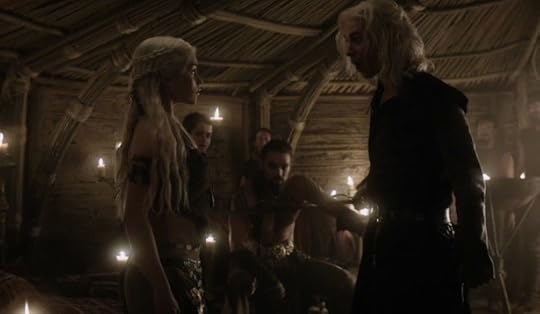
Surpised, Viserys relaxes, then is grabbed from behind by Drogo’s bloodriders, who break his arm. Drogo throws some gold into a pot to melt, and Viserys pleads with his sister to save him. It falls on deaf ears, and she refuses to look away from what is about to happen.
Drogo says, “A crown for a king,” (the best) and pours the gold on Visery’s head, brutally murdering him, but fulfilling his payment.
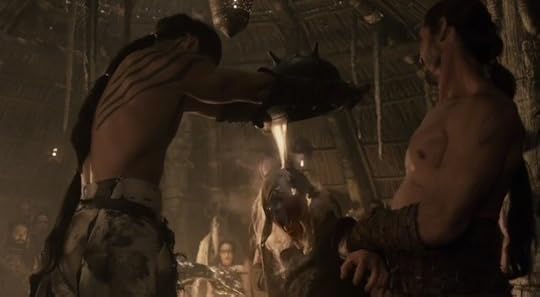
And just in case we didn’t notice the whole “her hands didn’t burn” moment from earlier, Daenerys ends the episode by saying, “He was no dragon. Fire cannot kill a dragon.”
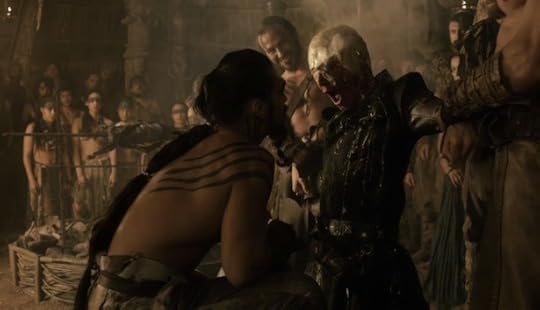
The short, miserable life of Viserys the Beggar King, comes to a horrible, glorious, ironic end. It doesn’t happen often, but sometimes bad things do happen to bad people in this story. Which we should all hold on to as we get closer to season one’s end.
What did you think of this episode? Tell us in the comments below.
Images: HBO
Schlock & Awe: THE HOWLING Gets Wolfier with Age
Something was in the air in 1981. I don’t know firsthand, of course, because I was negative 3 years old, but there sure seemed to be a lot of love for werewolves in the movies that year. Traditionally—in the humble opinion of me—there haven’t been very many good werewolf movies, but in 1981, there were three, and not just little low-budget affairs; three big ol’ studio releases. One is John Landis‘ unadulterated masterpiece An American Werewolf in London; another is the weird metaphysical wolves-in-New-York movie Wolfen; and the final, which has grown on me intensely, is Joe Dante‘s The Howling.
I was a horror snob of sorts back in college a decade ago, and pretty much if the horror was mixed with any kind of overt satire, I was not a fan. I’ve recently written about how I came around to Dan O’Bannon’s The Return of the Living Dead from what I originally thought which was an affront to Romero zombie movies everywhere. Another victim at the time of my guileless horror purity was Joe Dante who has since become one of my favorite directors, dating all the way back to Piranha. When I first saw The Howling, I thought it paled in comparison to American Werewolf, but now it hits me how funny it is, how well the story unfolds, and how much it skewers the idea of self-help gurus and healing spas that were so the rage in the early ’80s. This kind of storytelling is a hallmark of both Dante’s cinema and of screenwriter John Sayles.
The film, from a novel by Gary Brandner, follows Dee Wallace as reporter Karen White. Karen is being stalked by serial killer Eddie Quist (Dante movie regular Robert Picardo) and she agrees to take part in a sting operation with the police to meet Quist in a seedy porno theater (as opposed to the high-class and totally welcoming porno theaters). While in the theater, Quist makes Karen watch a snuff film and when she turns around to face him, she screams and passes out. The police storm in and shoot him dead, but her horror doesn’t stop. She has trauma-induced amnesia and is plagued by terrible dreams, which puts her romantic life with her husband Bill (Christopher Stone) at a bit of a impasse. Her psychiatrist (Patrick Macnee) tells the pair of them to take a weekend retreat to “the Colony,” a new-age wellness spa in the woods.
Things immediately start going south when the couple arrives. Bill is seduced by Marsha Quist (Elisabeth Brooks), whom we find out is Eddie’s sister, and he’s then attacked by a large dog (yeah, sure) after he resists her not-subtle-in-the-least come-ons. Plus, most of the other people at the retreat are weird, too. Karen calls her friend Terri (Belinda Balaski) to come and join her, and Terri, being a clever sort, does some digging and finds that the Colony is where Eddie Quist used to live, and the people in the community are covering up for him. Oh, and he’s still alive. And a werewolf. And they’re all werewolves. And now Bill’s a werewolf too.
When initially I saw the movie, I didn’t really appreciate the slow-building nature of the film, nor the subtlety in the screenplay. We spend a lot of time at the Colony before we really get a sense of anything werewolfy going on, but we do get a very good sense that the people there are up to no good. A lot of this comes from the casting of several of the supporting roles with known horror and genre movie staples like John Carradine, Slim Pickens, Kevin McCarthy, and Dante’s good luck charm Dick Miller, who plays the helpful yet grumpy (a Miller hallmark) bookstore owner who gives information and silver bullets to Terri’s boyfriend (played by Dennis Dugan, who has the dubious honor of having directed eight Adam Sandler movies…). Also, fun fact, many of the characters have the names of people who directed werewolf movies in the past, like George Waggner (The Wolf-Man), Terence Fisher (The Curse of the Werewolf), and Freddie Francis (Legend of the Werewolf).
Most of the werewolf effects glory goes to Rick Baker for his American Werewolf, which certainly was exemplary, but we absolutely have to doff our caps to Rob Bottin for his work in The Howling. The famous story goes that Landis had made a deal with Baker years earlier to do the effects on his werewolf movie, but in the interim, Baker had signed on to work for Dante on this movie. Landis wasn’t pleased and eventually Baker came back for the original project and Bottin was brought in. Having already done the atmospheric ghost effects for The Fog, Bottin created some in-depth stretching and bubbling effects for the centerpiece sequence when Quist transforms into a giant werewolf right in front of Karen. It makes sense that Bottin went on to do the gloriously gross effects in Carpenter’s The Thing.
The work on the scene by all parts of the effects—including the half-shadows in which they happen—is tremendous, though I have to admit that it’s still a scene I don’t think works very well in the overall story. Quist, who isn’t dead, sits up on a gurney in a laboratory with Karen right there and begins to transform. She grabs a beaker full of acid to defend herself. Then he takes like three or four full minutes of screen time to change, with different shots showing off different parts of his face and hands turning into a lupine monster, and then the second he’s done and fully in wolf form, she chucks the acid in his face and runs. Did she have to wait that whole time?!?! Was she just being polite? “Oh, I’m scared and want to throw acid at him, but it’s so rude to acid-face someone mid-transformation. I’ll wait.” Anyway, it’s still great effects, but the scene itself never fails to make me laugh.
This scene aside, The Howling is a movie that’s gotten better and better every time I’ve watched it. There’s so much to enjoy about it, from the wry screenplay from Sayles to the legitimately tense and scary sequences of werewolfery, to the nutso-weird ending where the whole of the Colony show their true colors, and then Karen sets out to prove to the world that werewolves exist even if it kills her. It’s a movie that I’ll put on some evenings just to have a good time. Several sequels have been made, to varying degrees of awfulness, starting with The Howling II: Your Sister is a Werewolf and followed by the zany Australian riff, The Howling III: The Marsupials. You can probably avoid those, but this one is well worth a howl at the moon.
Images: AVCO Embassy
Kyle Anderson is the Associate Editor for Nerdist. He writes the weekly look at weird or obscure films in Schlock & Awe. Follow him on Twitter!
Chris Hardwick's Blog
- Chris Hardwick's profile
- 132 followers


